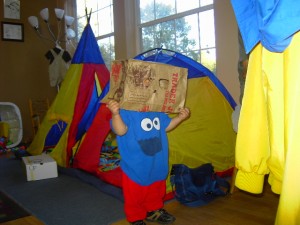How Everyday Storytelling Can Enhance Your Child’s Life – and Learning!
“Remember when you were little and we used to visit Eva across the street?” I reminisced with my daughter. “Eva ordered Girl Scout cookies from you, and when we went to deliver them, she insisted she never ordered any.”
My daughter laughed, then made a momentary sad-face.
We didn’t know at the time that Eva had Alzheimer’s. “Remember when she asked if you wanted a dish of ice cream? She went into the kitchen and came back without it,” I recalled.
Story is life. When we talk to our children about the events that happen to them, we help them clarify and store memories in a safe place – a place of nurture and support.
When parents tell kids stories from an early age, the characters and lessons are forever ingrained. Without preaching or cajoling, kids take away an impression that helps them become whoever and whatever they were meant to be in this world.
Even playing pat-a-cake, as Mommy smiles and holds her baby’s hands, makes an indelible impression. A child remembers his mother’s voice, cadence and smiles through what scientists call “mirror neurons” that become part of the child’s behavioral repertoire. And so we smile at our little ones, and use a pleasant tone.
“Tell me about the olden days, Daddy,” I begged my father. He grew up during the depression, and not only were his stories tragic, they left me feeling helpless: his father left in search of work in California’s nascent aircraft industry when my dad was four. He never came back. While I grew up with plenty, I felt his poverty and shame as though it were my own, and I could visualize him leaving for school, staring down in at his sister’s hand-me-down shoes. His memories are my memories now.
I should have felt better by comparison, but did not. I had my own stupid shoes: sensible brown ones called oxfords that my mother bought at the Poll Parrot store. “Poll parrot. Poll Parrot. They’re the shoes you want to buy. They make your feet run faster, as fast as I can fly. Squawk! Poll Parrot!!!”
I desperately wanted to wear my Sunday shoes to school – at least once in a while, like the other girls. But my mother made me wear brown, lace-up oxfords through the third grade. I abhorred them. And one morning, feeling rebellious, I hid the clunky monsters behind the sofa.
My mother would not have it. She steamed, like an army drill sergeant, “Find those shoes!”
I remember shoving the sofa out from the wall as she watched in her red lipstick. Defeated, I left the shiny shoes at home. While the oxfords seemed hideous to me, they made pretty shadows. In the evening I would stand in the driveway and turn my foot this way and that, pretending they were my pretty patent leathers.
Such stories show children that parents are people, too. We’re not perfect. And we had feelings and ideas that were different from the adults in our world. But what if kids don’t want to listen?
Parents can stretch their children’s listening ability, build vocabulary and practice verbal expression by doing something called “daily reminiscing.” Not about the long-ago past, but what happens day-to-day.
The March 2012 issue of the National Childbirth Trust journal Perspective features a research overview compiled by Dr. Cathy Hamer, policy and communications manager of the UK’s National Literacy Trust. One of the briefs discusses the art of “reminiscing” with children. Let me say that this type of interaction also helps strengthen children’s auditory memory, which is important for beginning reading.
“Parents with children of all ages can enhance their children’s language by talking about interesting events daily and encouraging children to do the same. An elaborative style (including varying intonation, information about causes and effects, people’s motives, descriptions of objects and actions) is important for language development and for enhancing children’s understanding of emotion and mind.”
The article continues, “Both the amount and type of talk are important. In particular, reminiscing about events is a particularly effective way of helping young children understand, and use, words. This involves a context that is personally meaningful, elaboration by the parent, the use of questions and explanations.
The brief explains four particular aspects of an effective reminiscing style:
- Wh-questions (who, what, where, etc.)
- Associations (linking the event to the child’s prior knowledge)
- Follow-ins (encouraging aspects of the conversation that the child is interested in)
- Evaluations (praise)
When we are in the midst of the intensive parenting years, it seems they will last forever. But the truth is, we have our children at home for only a short time. And what we have at the end is what we put in. I hope you have stories. FFG






Leave a Reply